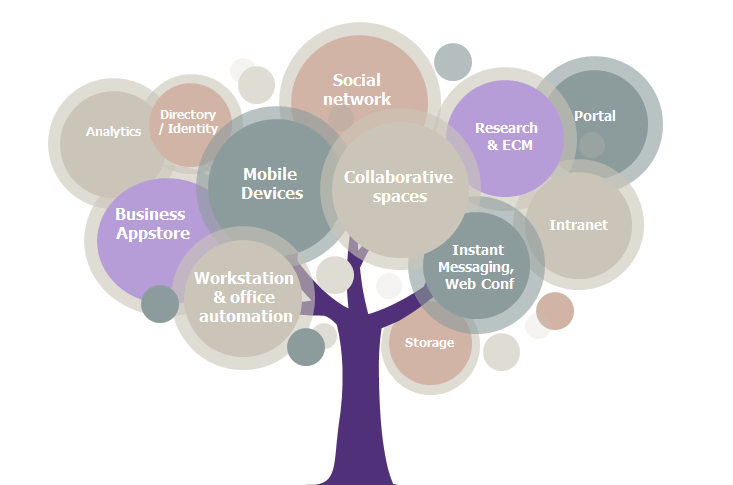The Digital Workplace is a currently a flourishing concept in business. It involves replacing aging office and communication equipment to offer employees a set of state-of-the-art digital features and services to lay the essential foundation for the company to support its digital transformation.
Although simple in principle, the operational implementation of the Digital Workplace is actually tricky, and the challenges differ according to the adopted project approach!
Here is an overview of the various scenarios and the lessons to be learned.

The Digital Workplace: a flourishing concept
An overly restrictive “IT project” approach
The first instinct is to consider “Digital Workplace” projects to be inherently an IT issue and to allow IT departments to handle them 100%.
IT departments are the natural interfaces with solution publishers, themselves the primary promoters of the Digital Workplace, as illustrated by the market’s evolution towards:
- solutions that package an increasingly broad set of tools ranging from office automation and messaging to corporate social networking as well as collaborative tools and personal storage spaces,
- increasingly cloud-based solutions in response to economic issues (cost of use, shifting of charges and costs associated with the physical infrastructure, etc.) such as smoother access (“anytime, anywhere, any device”)
- and solutions adaptable to each of the user’s situations of use.
The key point lies in the rather structuring nature for IT departments of adopting such solutions, which sometimes takes precedence over the search for user benefit.
Take the example of cloud solutions such as Microsoft’s Office 365 or even Google Apps.
For an IT department historically structured to host, operate, and maintain messaging services, document spaces, etc., their adoption raises real questions in terms of:
- organization of operation: drastic changes in publisher release cycles, sustainability of certain positions (administrators, technicians, and even IT support, whose workload should lighten up considerably)
- and evolution of skills of IT teams: changes in the nature of service operations, increasing proportion of requests for mobile apps, etc.
Many companies are therefore developing Digital Workplace business cases based on criteria of IT savings and improvement of average individual productivity. They then conduct the project with two logical priorities:
- focusing energy on the technical, migration, and deployment aspects and managing the change with the IT teams,
- giving reassurance in familiarization with new tools by employees to make them individually operational.
The benefit for the company actually now lies in having the foundation of collaborative solutions and having aligned the skills and organization of IT teams with this new model.
The risk in this scenario is that not enough meaning will be given to the users and that the target level of dissemination of collaborative and social uses will be missed for lack of real change management.
This results in:
- timid use of the new tools’ features by users,
- an identical replica of past practices! This is particularly the case for “as is” migration of old document bases into new collaborative spaces.
- user frustration over the “promise” of collaborative and social tools when they ultimately have trouble in their collective use.
This IT project approach provides the essential foundation but presents a limited impact in terms of transformation.
A sometimes intimidating “cross-functional” approach
Others are making the Digital Workplace a corporate project from the outset and entrusting responsibility to a team consisting of the IT department and a cross-functional department (HR department, communication department, or Chief Digital Officer).
This assumes that the collaborative and digital foundation cannot be only technological, but inevitably must focus on the company’s cross-functional practices, mainly HR and communication.
This challenge in this case is twofold:
- ensuring a certain degree of universalityby bringing all employees on board in the digital experience, even if a segmented approach will be adopted for the definition of services,
- enabling employees to understand and adoptcollaborative uses through suitable communication and change management.
The benefit for the company is conveying a strong, clear message about the digital transformation under way and beginning to make it more tangible by implementing tools.
However, this scenario is not as idyllic as it sounds. There is actually a risk that the ambition will run up against the magnitude of tasks to be carried out head on, and if the company is not careful, it could find itself stuck midstream with results that are not tangible enough to maintain the momentum:
- Pursuit of a target equipping rate – with mobile devices, for example – before actually being able to process targeted contents and services with true added value,
- Difficulty covering the entire spectrum of digital governance: security and compliance related to collaborative and social uses, enrichment and “validity” of information between the intranet, the corporate social network, and the collaborative spaces, best practices in terms of moderating and leading communities, etc.
- Fear of opening up a can of worms in terms of HR practices: work arrangements and reflecting them in contracts, room left for employee initiative and personal branding in the model, impact on the management of a paradigm shift (managers overwhelmed by their employees in terms of mastery of topics), etc.
This cross-functional approach set the company’s transformation in stone but struggles to bring it to life.
Testing and learning directly with the business areas
Essentially, if it is so complicated to make an internal transformation project a success, why not just focus on the digital transformation on the front office/customer side? These are visible initiatives with an easily measurable return on investment conducted with business area players (marketing, customer relations, sales, or even after-sales) and more appealing with respect to digital.
In reality, far from being antagonistic, the two types of initiatives form a solid union to serve the company’s performance. The Digital Workplace thrives on the maturity developed as part of customer digital programs by the front office business areas and puts them in the situation of natural “champions” to pave the way, set an example, and lead others in adopting collaborative and social uses.
That said, it would be simplistic to consider that only the business areas closest to the customers have developed real maturity on the digital and collaborative front, and other activities can often round out this panel (recruitment, procurement, business intelligence, etc.).
In any event, there is actually a third type of approach: implementing and learning with a limited number of business areas to quickly provide significant results and gradually expand to others.
- This isn’t merely a question of conducting a pilot phase, but applying a “test & learn” mode to an initial set of business area clusters in real operating situations. The project team then becomes immersed in the business area team and supports it to identify opportunities, adapt the services, and measure the value.
- The resulting success stories in terms of leading teams, sharing knowledge, making internal and external exchanges smoother, constructing together within communities, mobile business uses and services, etc. will be enriched through project communication, but above all will inspire others through their viral nature.
The benefits for the company appear obvious: quickly making the internal contributions of digital concrete by pointing to real business area successes to prove that a traditional top-down approach would have struggled to do, optimizing the investment in terms of support by relying on an approach perfectly aligned with the values of digital.
Of course, there are risks:
- Shifting between the “test & learn” ambition and the project team’s ability to break from the traditional project owner/project manager mode of operation or work in a truly agile mode,
- Insufficient upstream preparation: the “test & learn” mode works only if the Digital Workplace’s tools are already truly operational,
- Stopping support after the first success stories, while things are now getting serious for all the other business areas…
This “test & learn” approach yields concrete results but will only have the effects of a blitz if it is not part of a systemic approach.
And the winner is… a mixed approach!
In the end, a successful Digital Workplace project will draw from the ingredients of success in the three project approaches described above.
While securing the technological component, particular attention should be given to proximity and support for the business areas, because it is mainly through significant, value-creating (or savings-creating) successes in the field that the Digital Workplace will truly be established.
The ideal project approach therefore includes three aspects, ideally carried out almost concurrently:
- Enabling
- A pragmatic approach of implementing tools and devices and upgrading the infrastructure, particularly the network, to ensure service quality,
- Support for the IT teams in their transformation to adapt to new offerings and new concepts,
- Communication to allow employees to understand the meaning and self-learning materials based on digital tools (videos, e-learning) to maximize individual effectiveness.
- Putting common practices in place
- Managing the change by relying especially on local relays using clusters around them to master the solutions,
- Capitalizing on early adopters, who therefore have a high amount of knowledge, and coordinating them as communities so that they can participate in the dissemination of practices (reverse mentoring, etc.),
- Providing common cross-functional bases of governance allowing everyone to understand how to use the common tools properly and therefore develop practices harmoniously.
- Testing, learning, and adopting
- Identifying business area champions whose activity, maturity, or desire is best suited for quick, value-creating implementation,
- “Test & learn” with their terms in order to make the business area contributions of the Digital Workplace more tangible and refining then sharing success stories and lessons with the rest of the company,
- Enriching governance, creating the transformation roadmap together, and steering it with the “core” departments (IT, Security/Compliance, HR, Legal, Communication).
Such an approach is no more complicated to put in place than more standard approaches, and given the costly pitfalls that it will avoid for the company, the investment made – particularly by supporting the business areas – will quickly pay for itself.



